Influence of Hf Doping on the Oxygen Behaviors on ZrCo(110) Surface Using First-Principles Calculation
Abstract
:1. Introduction
2. Computational Methods
3. Results and Discussion
3.1. Structures Relaxation
3.2. O2 Molecules Adsorption and Dissociation
3.3. O Atoms Adsorption
3.4. Diffusion of Oxygen
3.5. Inward Diffusion of Hydrogen
3.6. Partial Density of State
3.7. Differential Charge Density
3.8. Bader Charge Analysis
4. Conclusions
Supplementary Materials
Author Contributions
Funding
Institutional Review Board Statement
Informed Consent Statement
Data Availability Statement
Conflicts of Interest
References
- Pease, R.S. Potential of controlled nuclear fusion. Contemp. Phys. 1977, 18, 113–135. [Google Scholar] [CrossRef]
- Juarez, R.; Pedroche, G.; Loughlin, M.J.; Pampin, R.; Martinez, P.; De Pietri, M.; Alguacil, J.; Ogando, F.; Sauvan, P.; Lopez-Revelles, A.J.; et al. A full and heterogeneous model of the ITER tokamak for comprehensive nuclear analyses. Nat. Energy 2021, 6, 150–157. [Google Scholar] [CrossRef]
- Yamamoto, T.; Supardjo; Terai, T.; Ono, F.; Tanaka, S.; Yamawaki, M. Storage of hydrogen isotopes in uranium alloys. Fusion Technol. 1988, 14, 764–768. [Google Scholar] [CrossRef]
- Penzhorn, R.D.; Devillers, M.; Sirch, M. Evaluation of ZrCo and other getters for tritium handling and storage. J. Nucl. Mater. 1990, 170, 217–231. [Google Scholar] [CrossRef]
- Maynard, K.J.; Shmayda, W.T.; Heics, A.G. Tritium aging effects in zirconium-cobalt. Fusion Technol. 1995, 28, 1391–1398. [Google Scholar] [CrossRef]
- Shim, M.; Chung, H.; Yoshida, H.; Jin, H.; Lee, J.; Song, K.M.; Chang, M.H.; Kang, H.G.; Yun, S.H.; Cho, S. Hydriding/dehydriding characteristics on fast heat transfer response ZrCo bed for ITER. Fusion Eng. Des. 2009, 84, 1763–1766. [Google Scholar] [CrossRef]
- Kenjo, S.; Ogino, Y.; Mukai, K.; Bakr, M.; Yagi, J.; Konishi, S. Employing of ZrCo as a fuel source in a discharge-type fusion neutron source operated in self-sufficient mode. Int. J. Hydrogen Energy 2022, 47, 3054–3062. [Google Scholar] [CrossRef]
- Candido, L.; Aiello, A.; La Rovere, S.; Moreno, C.; Ortiz-Ferrer, C.; Ricapito, I. Overview of tritium management in WCLL test blanket system of ITER. Fusion Eng. Des. 2024, 200, 114163. [Google Scholar] [CrossRef]
- Shmayda, W.T.; Heics, A.G.; Kherani, N.P. Comparison of uranium and zirconium cobalt for tritium storage. J. Less-Common Met. 1990, 162, 117–127. [Google Scholar] [CrossRef]
- Devillers, M.; Sirch, M.; Penzhorn, R.D. Hydrogen-induced disproportionation of the intermetallic compound ZrCo. Chem. Mater. 1992, 4, 631–639. [Google Scholar] [CrossRef]
- Bekris, N.; Sirch, M. On the mechanism of the disproportionation of ZrCo hydrides. Fusion Sci. Technol. 2012, 62, 50–55. [Google Scholar] [CrossRef]
- Jat, R.A.; Singh, R.; Pati, S.; Sastry, P.U.; Das, A.; Agarwal, R.; Parida, S.C. An analogy of interstitial site occupancy and hydrogen induced disproportionation of Zr1-xTixCo ternary alloys. Int. J. Hydrogen Energy 2017, 42, 8089–8097. [Google Scholar] [CrossRef]
- Monea, B.F.; Ionete, E.I.; Ducu, C.; Spiridon, S.I.; Moga, S.; Han, X.B.; Liu, W. Synthesis, Characterization, and Hydrogen Isotope Storage Properties of Zr1-xTixCo and Zr1-xHf xCo Alloys (x = 0.1, 0.2). Fusion Sci. Technol. 2021, 77, 382–390. [Google Scholar] [CrossRef]
- Jat, R.A.; Rawat, D.; Sharma, A.; Parida, S.C. Remarkable enhancement in durability of ZrCo alloy against hydrogen induced disproportionation by Ti and Nb co-substitution. Int. J. Hydrogen Energy 2023, 48, 7431–7441. [Google Scholar] [CrossRef]
- Song, C.Y.; Ding, F.Y.; Ye, R.X.; Song, J.F.; Zong, H.X.; Chen, X.H.; Zhou, L.S. Hydrogen diffusion and anti-disproportionation properties in ZrCo alloys: The effect of Sc, V, and Ni dopants. Int. J. Hydrogen Energy 2023, 48, 23607–23619. [Google Scholar] [CrossRef]
- Glasbrenner, H.; Klewenebenius, H.; Bruns, M.; Pfennig, G.; Penzhorn, R.D.; Ache, H.J. Surface analytical investigation of the tritium getter ZrCo after exposure to various gases. Mikrochim. Acta 1992, 107, 207–217. [Google Scholar] [CrossRef]
- Li, H.L.; Wang, S.M.; Jiang, L.J.; Zhang, L.D.; Liu, X.P.; Li, Z.N. Preparation and research on poisoning resistant Zr-Co based hydrogen storage alloys. Rare Met. 2008, 27, 367–370. [Google Scholar] [CrossRef]
- Guo, X.M.; Wang, S.M.; Li, Z.N.; Yuan, B.L.; Ye, J.H.; Qiu, H.C.; Wu, Y.F.; Liu, X.P.; Jiang, L.J. Study on the poisoning resistance of Pd-coated ZrCo alloy prepared by electroless plating method. Fusion Eng. Des. 2016, 113, 195–200. [Google Scholar] [CrossRef]
- Zhang, T.B.; Zhang, Y.L.; Zhang, M.; Hu, R.; Kou, H.C.; Li, J.S.; Xue, X.Y. Hydrogen absorption behavior of Zr-based getter materials with Pd-Ag coating against gaseous impurities. Int. J. Hydrogen Energy 2016, 41, 14778–14787. [Google Scholar] [CrossRef]
- Zhang, G.H.; Tang, T.; Sang, G.; Xiong, Y.F.; Kou, H.Q.; Wu, W.Q.; Wei, Y.J. Effect of Ti Modification on Hydrogenation Properties of ZrCo in the Presence of CO Contaminant Gas. Rare Met. Mater. Eng. 2017, 46, 3366–3373. [Google Scholar]
- Yang, S.; Fang, R.J.; Yang, G.; Lv, L.J.; Han, X.B.; Liu, W.; He, X.J.; Zhu, P.F. Influence of element substitutions on poisoning behavior of ZrV2 alloy: Theoretical and experimental investigations. Nucl. Sci. Tech. 2023, 34, 113. [Google Scholar] [CrossRef]
- Kresse, G.; Furthmuller, J. Efficiency of ab-initio total energy calculations for metals and semiconductors using a plane-wave basis set. Comput. Mater. Sci. 1996, 6, 15–50. [Google Scholar] [CrossRef]
- Perdew, J.P.; Chevary, J.A.; Vosko, S.H.; Jackson, K.A.; Pederson, M.R.; Singh, D.J.; Fiolhais, C. Atoms, molecules, solids and surfaces—Applications of the generalized gradient approximation for exchange and correlation. Phys. Rev. B 1992, 46, 6671–6687. [Google Scholar] [CrossRef] [PubMed]
- Chattaraj, D.; Kumar, N.; Ghosh, P.; Majumder, C.; Dash, S. Adsorption, dissociation and diffusion of hydrogen on the ZrCo surface and subsurface: A comprehensive study using first principles approach. Appl. Surf. Sci. 2017, 422, 394–405. [Google Scholar] [CrossRef]
- Pack, J.D.; Monkhorst, H.J. Special points for Brillouin-zone integrations—A reply. Phys. Rev. B 1977, 16, 1748–1749. [Google Scholar] [CrossRef]
- Yan, C.; Zeng, Q.F.; He, W.J.; Zhu, J.N. First-principles investigation on the adsorption and dissociation of O2 and H2O molecules on the Ni-rich TiNi alloy surface. Appl. Surf. Sci. 2020, 534, 147570. [Google Scholar] [CrossRef]
- Henkelman, G.; Uberuaga, B.P.; Jónsson, H. A climbing image nudged elastic band method for finding saddle points and minimum energy paths. J. Chem. Phys. 2000, 113, 9901–9904. [Google Scholar] [CrossRef]
- Harris, I.R.; Hussain, D.; Barraclough, K.G. Constitution of binary equiatomic alloys of Zr with Fe, Co and Ni. Scr. Metall. 1970, 4, 305–307. [Google Scholar] [CrossRef]
- Zhang, B.J.; Ye, X.Q.; Luo, W.H.; Sang, G. Influence of niobium/tantalum doping on the hydrogen behavior of ZrCo(110) surface. Int. J. Hydrogen Energy 2023, 48, 17577–17592. [Google Scholar] [CrossRef]
- Qin, C.L.; Yu, Y.S.; Xu, Z.H.; Du, J.G.; Zhao, L.; Jiang, G. The interaction of oxygen with the γ-U (001) and (110) surfaces: An ab initio study. Comput. Mater. Sci. 2023, 219, 112025. [Google Scholar] [CrossRef]
- Zhang, B.J.; Ye, X.Q.; Luo, W.H.; Sang, G. Micro-mechanism study on the effect of O2 poisoned ZrCo surface on hydrogen absorption performance. Int. J. Hydrogen Energy 2023, 48, 19605–19618. [Google Scholar] [CrossRef]

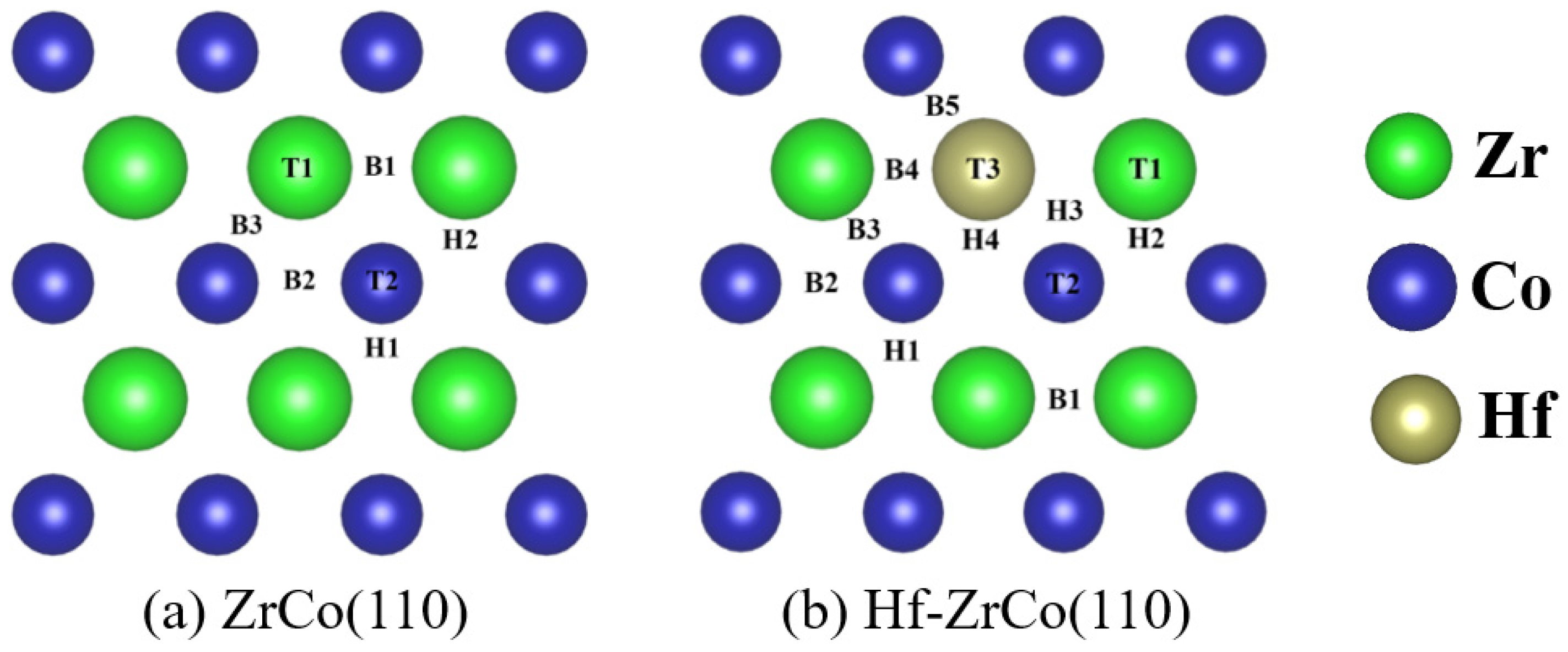
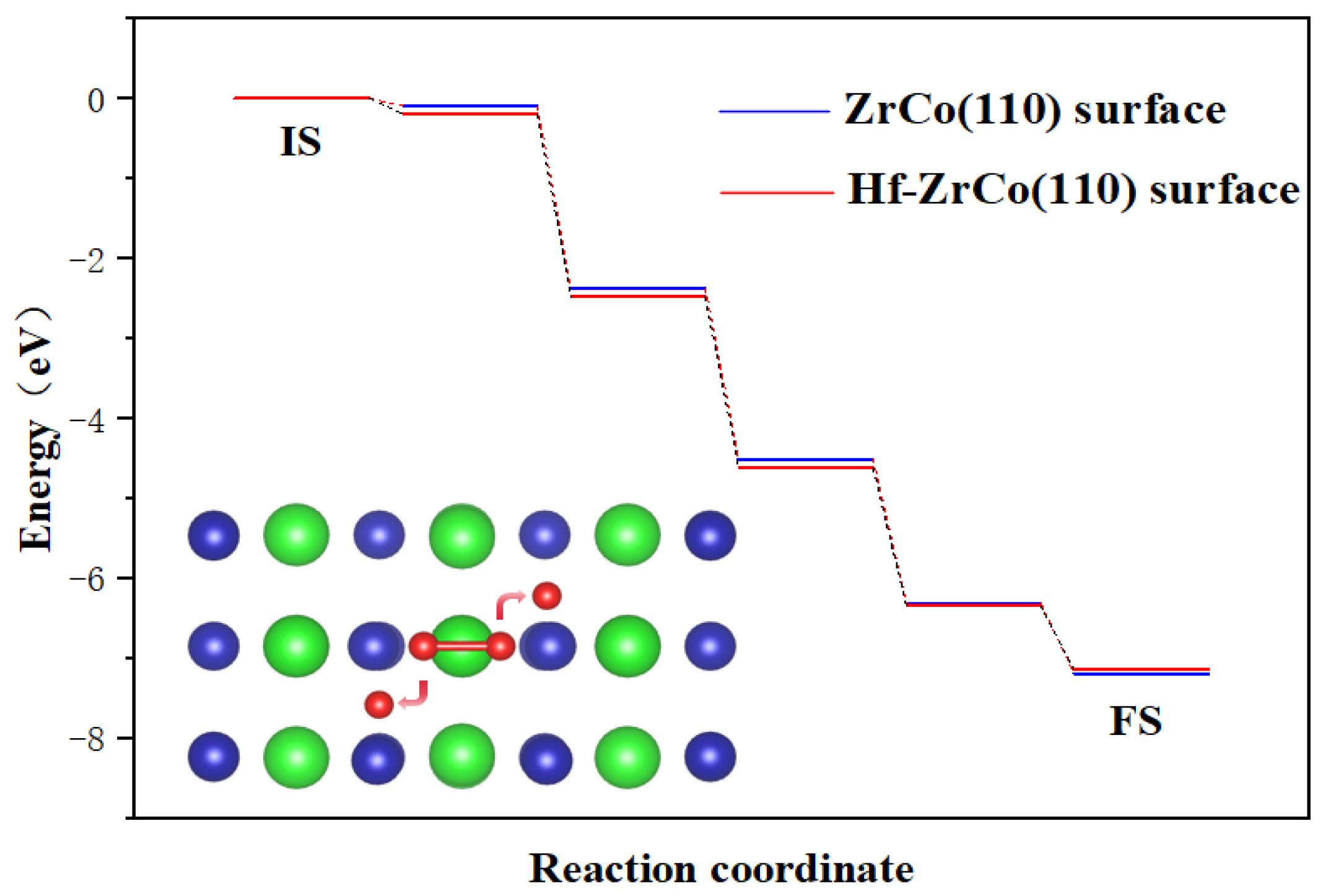
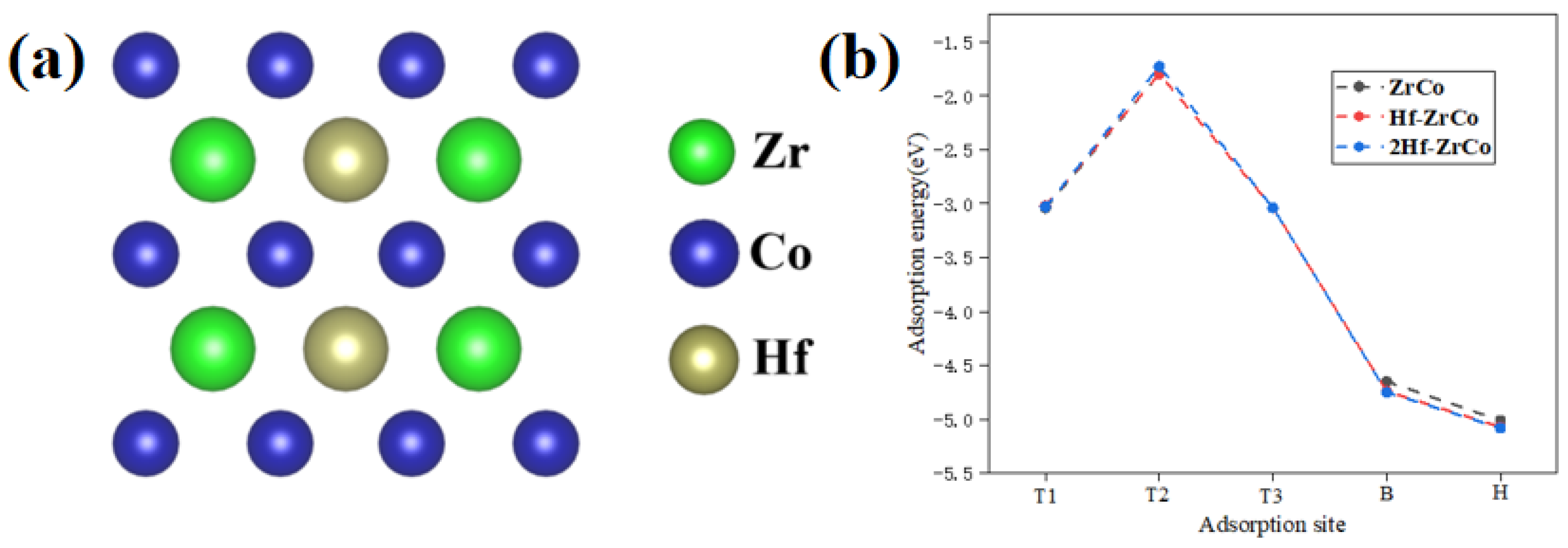

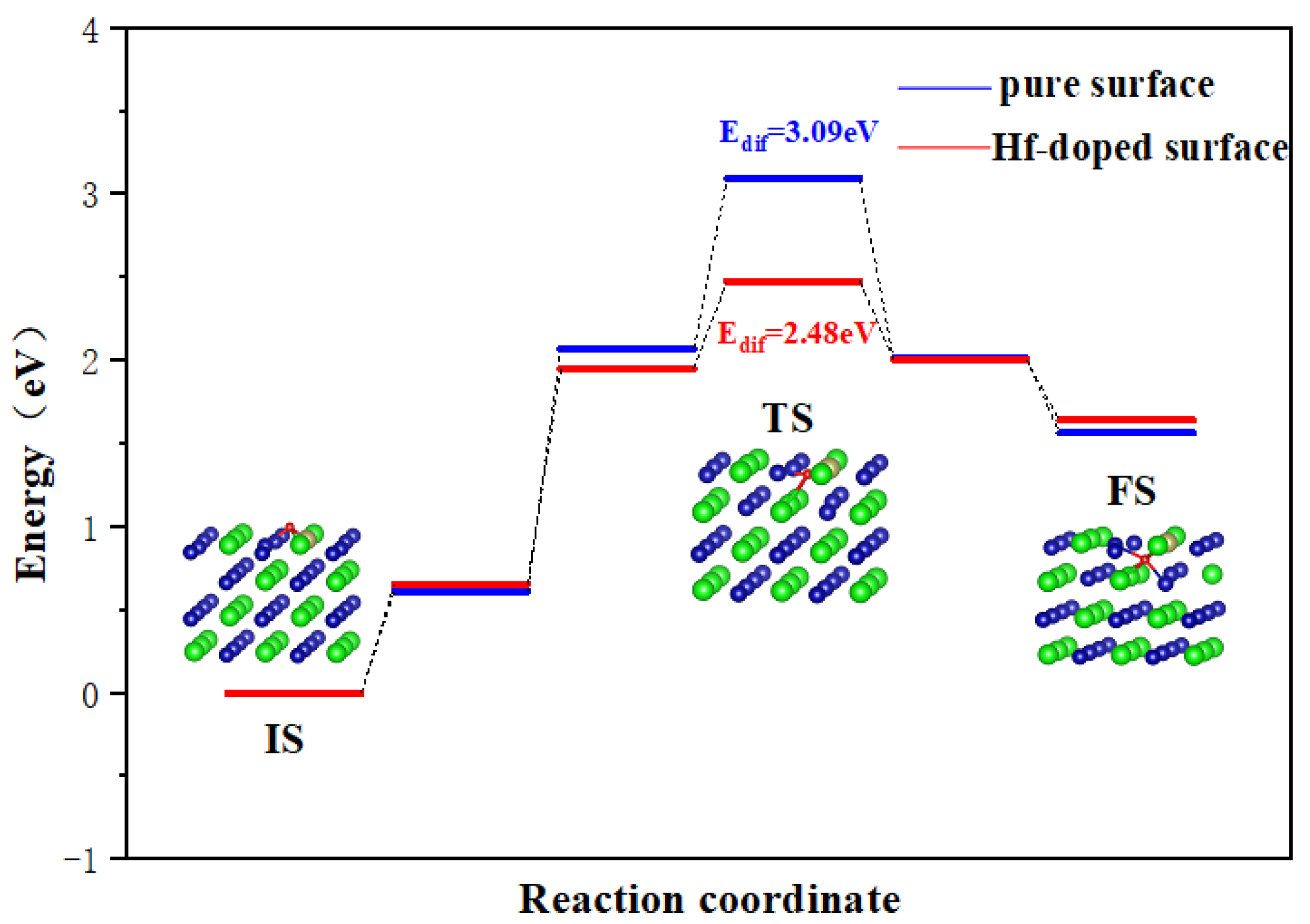

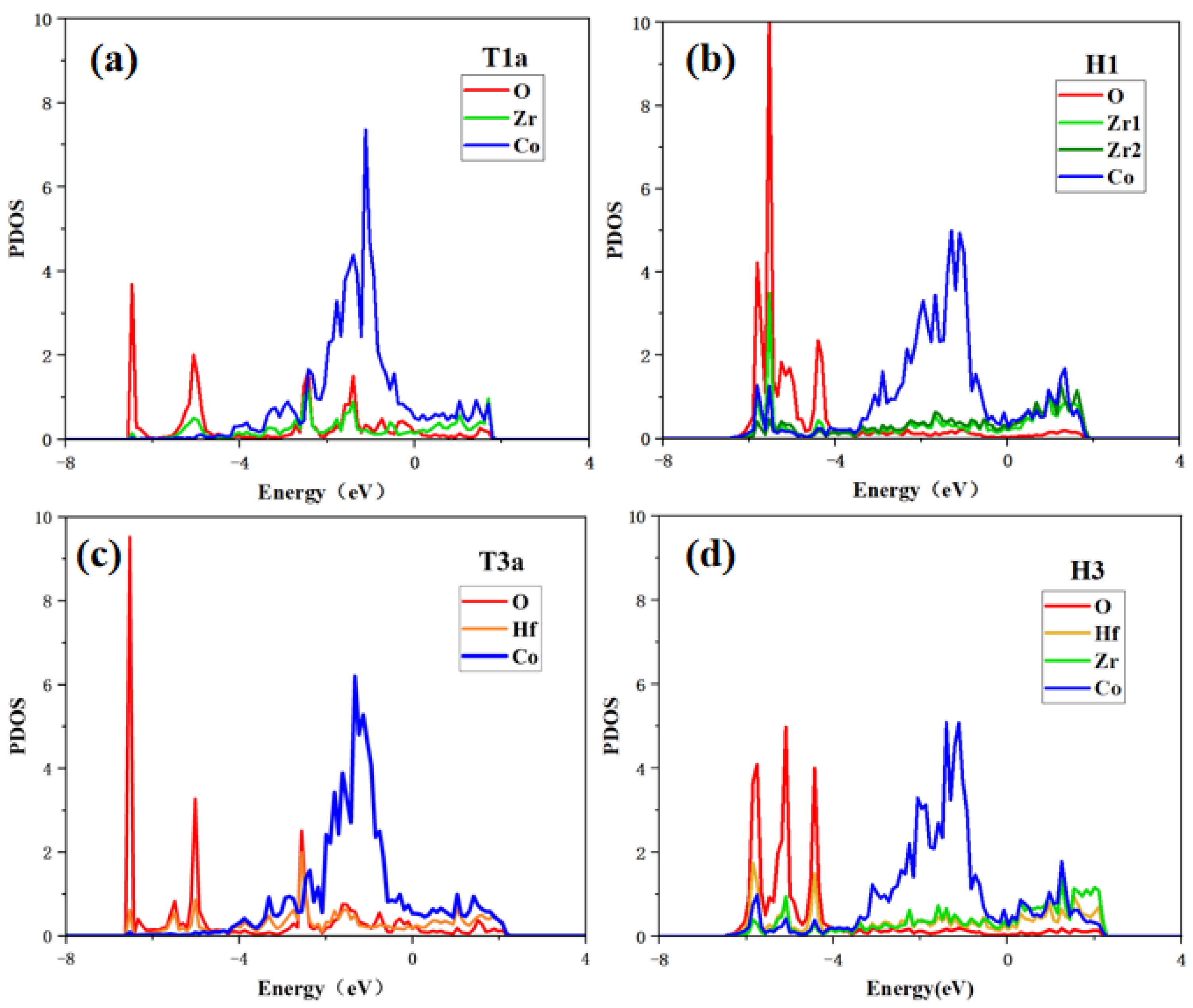
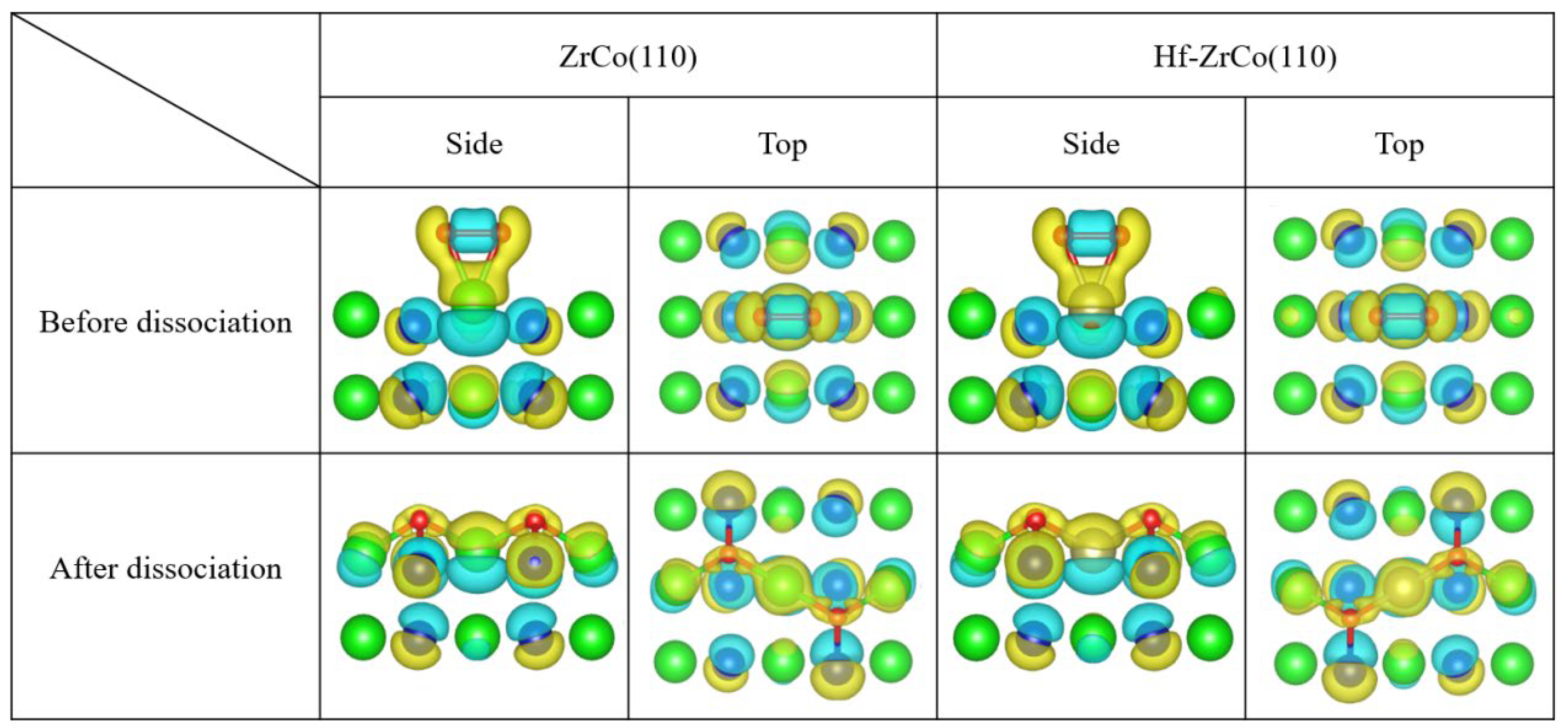
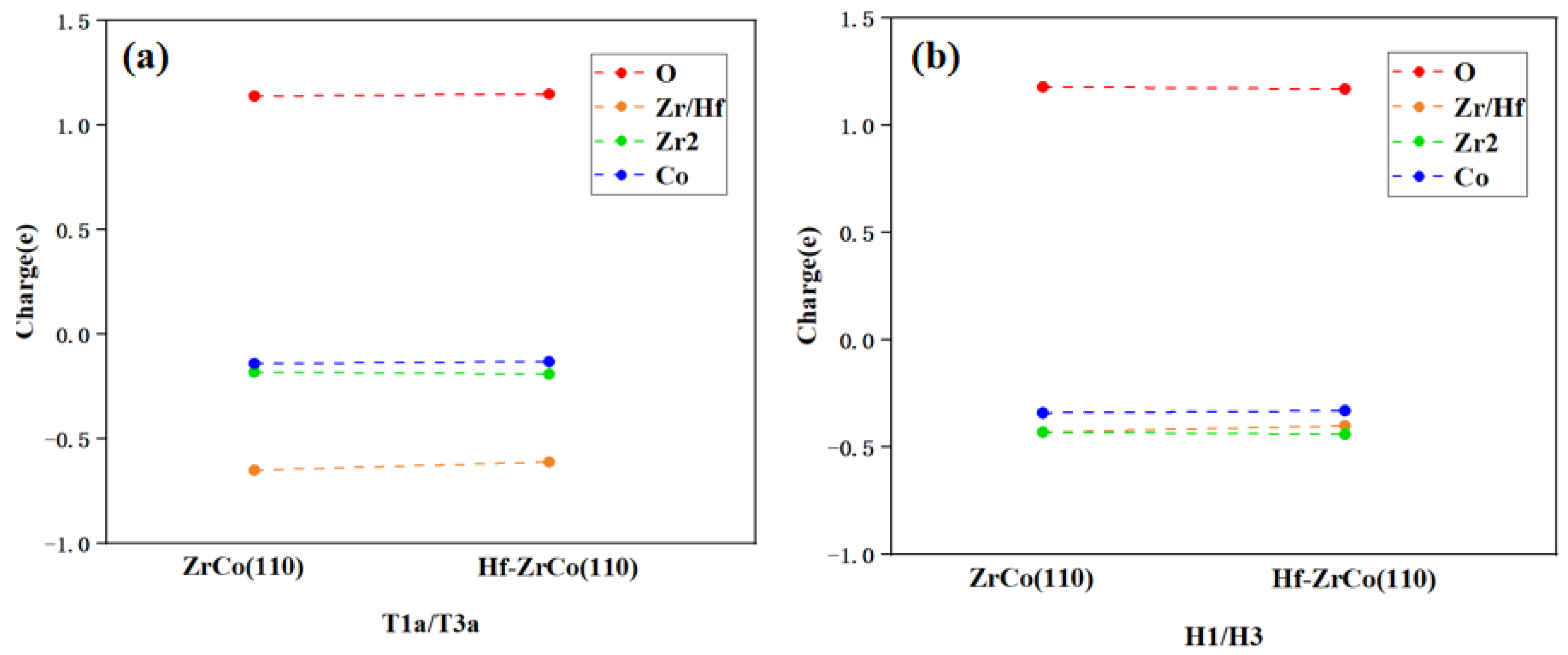
| Layer | ZrCo(110) | Hf-ZrCo(110) | ||||
|---|---|---|---|---|---|---|
| Before Relaxation | After Relaxation | Δd | Before Relaxation | After Relaxation | Δd | |
| 1st (Zr) | 6.775 | 6.769 | −0.08 | 6.775 | 6.760 | −0.22 |
| 1st (Co) | 6.775 | 6.478 | −4.38 | 6.775 | 6.474 | −4.44 |
| 1st (Hf) | - | - | - | 6.775 | 6.709 | −0.97 |
| 2nd (Zr) | 4.517 | 4.509 | −0.18 | 4.517 | 4.504 | −0.29 |
| 2nd (Co) | 4.517 | 4.590 | 1.61 | 4.517 | 4.575 | 1.28 |
| d12(Zr-Co) | 2.258 | 2.179 | −3.50 | 2.258 | 2.185 | −3.23 |
| d12(Co-Zr) | 2.258 | 1.969 | −12.80 | 2.258 | 1.970 | −12.75 |
| d12(Hf-Co) | - | - | - | 2.258 | 2.134 | −5.49 |
| Sites | ZrCo | Hf-ZrCo | ||
|---|---|---|---|---|
| Eads | dO-O | Eads | dO-O | |
| T1a | −2.95 | 1.480 | −2.92 | 1.479 |
| T1b | −2.91 | 1.488 | −2.89 | 1.486 |
| T2a | −7.93 | 3.533 | −7.83 | 3.460 |
| T2b | −9.66 | 3.021 | −9.74 | 3.040 |
| T3a | - | - | −3.07 | 1.493 |
| T3b | - | - | −3.01 | 1.501 |
| B1a | −3.59 | 1.452 | −3.36 | 1.451 |
| B1b | −8.77 | 2.460 | −8.79 | 2.477 |
| B2a | −4.01 | 1.455 | −4.02 | 1.456 |
| B2b | −8.77 | 2.461 | −8.79 | 2.459 |
| B3 | −10.14 | 3.727 | −10.16 | 3.727 |
| B4a | - | - | −3.66 | 1.460 |
| B4b | - | - | −8.81 | 2.436 |
| B5 | - | - | −10.21 | 3.727 |
| H1 | −9.88 | 4.517 | −9.95 | 4.540 |
| H2 | −9.99 | 3.277 | −10.01 | 3.276 |
| H3 | - | - | −9.95 | 4.495 |
| H4 | - | - | −10.08 | 3.201 |
| Sites | ZrCo | Hf-ZrCo | ||||
|---|---|---|---|---|---|---|
| Eads | do-surf | Note | Eads | do-surf | Note | |
| T1 | −3.04 | 2.18 | - | −3.02 | 2.19 | |
| T2 | −1.80 | 1.79 | - | −1.80 | 1.79 | |
| T3 | - | - | - | −3.04 | 2.09 | |
| B1 | −4.65 | 1.32 | - | −4.66 | 1.32 | |
| B2 | −4.12 | 0.09 | - | −4.15 | 0.10 | |
| B3 | −5.01 | 1.00 | to H1 | −5.07 | 0.99 | to H3 |
| B4 | - | - | - | −4.74 | 1.29 | |
| B5 | - | - | - | −5.07 | 1.00 | to H3 |
| H1 | −5.01 | 1.00 | - | −5.02 | 0.99 | |
| H2 | −4.12 | 0.09 | to B2 | −4.15 | 0.10 | to B2 |
| H3 | - | - | - | −5.07 | 0.99 | |
| H4 | - | - | - | −4.10 | 0.10 | to B2 |
Disclaimer/Publisher’s Note: The statements, opinions and data contained in all publications are solely those of the individual author(s) and contributor(s) and not of MDPI and/or the editor(s). MDPI and/or the editor(s) disclaim responsibility for any injury to people or property resulting from any ideas, methods, instructions or products referred to in the content. |
© 2024 by the authors. Licensee MDPI, Basel, Switzerland. This article is an open access article distributed under the terms and conditions of the Creative Commons Attribution (CC BY) license (https://creativecommons.org/licenses/by/4.0/).
Share and Cite
Qian, R.; Habibullah; Ye, M.; Cen, W.; Wu, C. Influence of Hf Doping on the Oxygen Behaviors on ZrCo(110) Surface Using First-Principles Calculation. Materials 2024, 17, 2424. https://doi.org/10.3390/ma17102424
Qian R, Habibullah, Ye M, Cen W, Wu C. Influence of Hf Doping on the Oxygen Behaviors on ZrCo(110) Surface Using First-Principles Calculation. Materials. 2024; 17(10):2424. https://doi.org/10.3390/ma17102424
Chicago/Turabian StyleQian, Ruijun, Habibullah, Meitong Ye, Wanglai Cen, and Chaoling Wu. 2024. "Influence of Hf Doping on the Oxygen Behaviors on ZrCo(110) Surface Using First-Principles Calculation" Materials 17, no. 10: 2424. https://doi.org/10.3390/ma17102424




